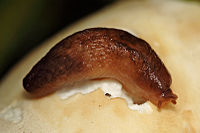
Fungivore
Encyclopedia

Animal
Animals are a major group of multicellular, eukaryotic organisms of the kingdom Animalia or Metazoa. Their body plan eventually becomes fixed as they develop, although some undergo a process of metamorphosis later on in their life. Most animals are motile, meaning they can move spontaneously and...
that primarily or solely feeds
Feeding
Feeding is the process by which organisms, typically animals, obtain food. Terminology often uses either the suffix -vore from Latin vorare, meaning 'to devour', or phagy, from Greek φαγειν, meaning 'to eat'.-Evolutionary history:...
upon living members of the fungus
Fungus
A fungus is a member of a large group of eukaryotic organisms that includes microorganisms such as yeasts and molds , as well as the more familiar mushrooms. These organisms are classified as a kingdom, Fungi, which is separate from plants, animals, and bacteria...
kingdom. Fungivory is a type of predation
Predation
In ecology, predation describes a biological interaction where a predator feeds on its prey . Predators may or may not kill their prey prior to feeding on them, but the act of predation always results in the death of its prey and the eventual absorption of the prey's tissue through consumption...
, and is an important part of the soil food web
Soil food web
The soil food web is the community of organisms living all or part of their lives in the soil. It describes a complex living system in the soil and how it interacts with the environment, plants, and animals....
. However, some animals that are quite strictly herbivorous, such as wombat
Wombat
Wombats are Australian marsupials; they are short-legged, muscular quadrupeds, approximately in length with a short, stubby tail. They are adaptable in their habitat tolerances, and are found in forested, mountainous, and heathland areas of south-eastern Australia, including Tasmania, as well as...
s, will consume fungi if they are available.
Fungi are renowned for their poison
Poison
In the context of biology, poisons are substances that can cause disturbances to organisms, usually by chemical reaction or other activity on the molecular scale, when a sufficient quantity is absorbed by an organism....
s to deter animals from feeding on them: even today humans die from eating poisonous fungi. A natural consequence of this is the virtual absence of obligate vertebrate
Vertebrate
Vertebrates are animals that are members of the subphylum Vertebrata . Vertebrates are the largest group of chordates, with currently about 58,000 species described. Vertebrates include the jawless fishes, bony fishes, sharks and rays, amphibians, reptiles, mammals, and birds...
fungivores. One of the few extant vertebrate fungivores is the northern flying squirrel
Northern Flying Squirrel
The Northern flying squirrel is one of two species of the genus Glaucomys, the only flying squirrels found in North America . Unlike most members of their family, flying squirrels are strictly nocturnal...
, but it is believed that in the past there were numerous vertebrate fungivores and that toxin development greatly lessened their number and forced these species to abandon fungi or diversify. Although some monkey
Monkey
A monkey is a primate, either an Old World monkey or a New World monkey. There are about 260 known living species of monkey. Many are arboreal, although there are species that live primarily on the ground, such as baboons. Monkeys are generally considered to be intelligent. Unlike apes, monkeys...
s still eat fungi today, there are no completely fungivorous primates, though their dentition is very suitable for eating fungi.
Examples of fungivores include:
- Athoracophorus bitentaculatusAthoracophorus bitentaculatusAthoracophorus bitentaculatus, is a species of land slug, a terrestrial gastropod mollusc in the family Athoracophoridae.- Ecology :Parasites of Athoracophorus bitentaculatus include:...
- a slug - AcariformesAcariformesThe Acariformes are the more diverse of the two superorders of mites. There are over 32,000 described species in 351 families, and an estimated total of 440,000 to 929,000, including undescribed species.-Systematics and taxonomy:...
- mites - AnisopodidaeAnisopodidaeAnisopodidae is a small cosmopolitan family of gnat-like flies known as wood gnats or window-gnats with 154 described extant species in 15 genera, and several described fossil taxa. Some species are saprophagous or fungivorous. They are mostly small to medium-sized flies, except the genera...
- flies - BibionomorphaBibionomorphaBibionomorpha is an infraorder of Nematocera. One of its constituent families, the Anisopodidae, is the presumed sister taxon to the entire suborder Brachycera. Several of the remaining families in the infraorder are former subfamilies of the Mycetophilidae, which has been recently subdivided...
- flies (larvae only) - Entomopathogenic nematodeEntomopathogenic nematodeEntomopathogenic nematodes are soil-inhabiting, lethal insect parasitoids that belong to the phylum Nematoda, commonly called roundworms. The term entomopathogenic comes from the Greek word entomon, meaning insect, and pathogenic, which means causing disease...
- nematode worms - Euprenolepis proceraEuprenolepis proceraEuprenolepis procera is a species of ant found in the rainforests of South East Asia. It was first described by Carlo Emery, an Italian entomologist in 1900. In 2008, Witte & Maschwitz discovered that E. procera specialises in harvesting mushrooms in the rainforest for food, representing a new,...
- ants - PotoroidaePotoroidaeThe marsupial family Potoroidae includes the bettongs, potoroos, and two of the rat-kangaroos. All are rabbit-sized, brown, jumping marsupials and resemble a large rodent or a very small wallaby.- Characteristics :...
- marsupial potoroos - PlatypezidaePlatypezidaePlatypezidae is a family of true flies of the superfamily Platypezoidea. The more than 250 species are found worldwide primarily in woodland habitats...
- flies - TydeidaeTydeidaeTydeidae is a family of acariform mites. These are generally small mites with muted colours. The body is soft, often with complex striated or reticulated patterns...
- mites - ZopherinaeZopherinaeZopherinae is a subfamily of beetles, commonly known as ironclad beetles. Together with the subfamily Usechinae they have been treated historically as a family, but have recently been joined by several additional taxa, making the Zopheridae a much larger composite family, and the Zopherinae are now...
- beetles

